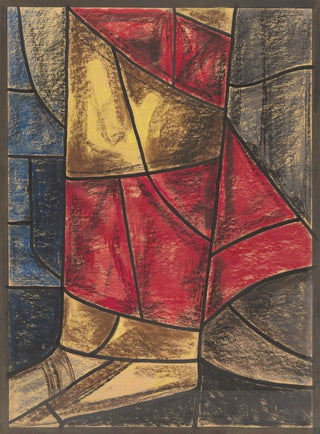Art print | Project of window in the north transept of the Dom Tower in Utrecht 2 - Richard Nicolas Roland Holst


View from behind

Frame (optional)
In the world of art, some works transcend their era to become timeless witnesses of human creativity. The art print of the Projet de fenêtre dans le transept nord de la tour Dom à Utrecht 2, created by Richard Nicolas Roland Holst, is a perfect example. This project, illustrating the fusion between spirituality and aesthetics, immerses us in the universe of an artist whose architectural and artistic vision flourishes at the heart of Dutch traditions. Gazing at this piece, one is immediately transported on a quest for light and color, where every detail seems to whisper ancient stories while evoking a striking modernity.
Style and uniqueness of the work
The style of Richard Nicolas Roland Holst is characterized by a delicacy and depth that are uniquely his own. In this art print, the artist explores geometric and floral motifs, typical of his symbolist approach. The flowing lines and organic shapes intertwine, creating a harmonious dialogue between the Gothic architecture of the transept and the Art Nouveau emerging in his time. The play of light, orchestrated by the stained glass windows imagined by Holst, transforms the sacred space into a true scene of life where color becomes an extension of spirituality. Every nuance, every reflection, plays a crucial role in the visual storytelling of the piece, inviting the viewer to meditative contemplation. Thus, this window is not merely a decorative element; it becomes a gateway to the invisible, a link between heaven and earth.
The artist and his influence
Richard Nicolas Roland Holst, an emblematic figure of Dutch art in the early 20th century, managed to establish himself through his ability to marry tradition and innovation. Influenced by the artistic movements of his time, notably symbolism and Art Nouveau, he developed a style that is uniquely his own, characterized by a great sensitivity to light and forms. His work on stained glass and frescoes marked public and private spaces, leaving a lasting imprint on the Dutch artistic landscape. Holst was not content with reproducing beauty; he sought to reveal its depth and

Matte finish

View from behind

Frame (optional)
In the world of art, some works transcend their era to become timeless witnesses of human creativity. The art print of the Projet de fenêtre dans le transept nord de la tour Dom à Utrecht 2, created by Richard Nicolas Roland Holst, is a perfect example. This project, illustrating the fusion between spirituality and aesthetics, immerses us in the universe of an artist whose architectural and artistic vision flourishes at the heart of Dutch traditions. Gazing at this piece, one is immediately transported on a quest for light and color, where every detail seems to whisper ancient stories while evoking a striking modernity.
Style and uniqueness of the work
The style of Richard Nicolas Roland Holst is characterized by a delicacy and depth that are uniquely his own. In this art print, the artist explores geometric and floral motifs, typical of his symbolist approach. The flowing lines and organic shapes intertwine, creating a harmonious dialogue between the Gothic architecture of the transept and the Art Nouveau emerging in his time. The play of light, orchestrated by the stained glass windows imagined by Holst, transforms the sacred space into a true scene of life where color becomes an extension of spirituality. Every nuance, every reflection, plays a crucial role in the visual storytelling of the piece, inviting the viewer to meditative contemplation. Thus, this window is not merely a decorative element; it becomes a gateway to the invisible, a link between heaven and earth.
The artist and his influence
Richard Nicolas Roland Holst, an emblematic figure of Dutch art in the early 20th century, managed to establish himself through his ability to marry tradition and innovation. Influenced by the artistic movements of his time, notably symbolism and Art Nouveau, he developed a style that is uniquely his own, characterized by a great sensitivity to light and forms. His work on stained glass and frescoes marked public and private spaces, leaving a lasting imprint on the Dutch artistic landscape. Holst was not content with reproducing beauty; he sought to reveal its depth and






